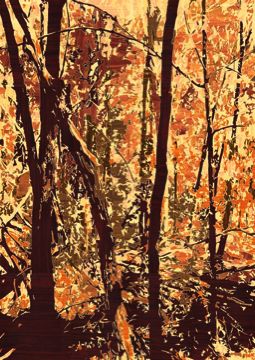Diese Seite ist für Browser optimiert, die Web-Standards unterstützen. Andere Browser zeigen lediglich eine vereinfachte Version an, ermöglichen jedoch ebenfalls den Zugang zu allen Texten dieser Site.
Artists
Click on artist's name to view detailsBarbara Visser
Barbara Visser (NL)
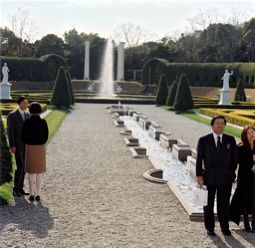
The works Barbara Visser has made over the past 10 years show a distinct fascination with concepts like identity, real and unreal, objective and manipulated reproduction. In A Day in Holland / Holland in a Day, too, she plays ingenious games with our notion of perception: historically-accurate reproduction or entertainment, functional space or two-dimensional scenery, an original face or a revised mask? Once more reality and representation are called into question.
Temporary Services
Temporary Services (US)
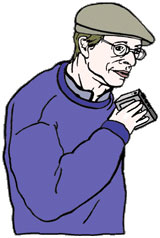
'Dave's Stories'
For Migrating Identity 'Transmission/Reconstruction' Temporary Services
is presenting a newly edited CD of recordings our friend Dave
Whitman made for us between 2001 and 2003. It contains over an
hour of stories about Dave and his life on the streets of Chicago.
Also, in cooperation with Z- Magazine, a newly written autobiographical
text of Dave Whitman will appear in the May 21st edition, along with
drawings of some of his favorite friends.
More information about Dave's Stories
As we live, so we work
Temporary Services is a group of three persons: Brett Bloom, Marc
Fischer, and Salem Collo-Julin. We draw on our varied backgrounds
and interests to incorporate our aesthetic practice within our
lived experiences. The need to create change within our daily lives
translates directly to our public projects.
We champion public projects that are temporary, ephemeral, or
that operate outside of conventional or officially sanctioned
categories of public expression. We appreciate such diverse activities
as makeshift roadside memorials to accident victims, temporary housing
encampments designed by homeless people, tree houses fabricated by
children, and idiosyncratic public notices that get stuffed inside the
display windows of free newspaper boxes. We like outdoor projects
that are encountered by surprise rather than sought out with
deliberation like exhibitions and special events. We especially
appreciate those projects that do not have permission and
challenge expected usages.
More information about Temporary Services
To Sang
To Sang (CN/NL)
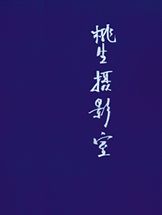
To Sang, a local portrait photographer in Amsterdam, presents citizens
on their own terms- reflecting their achievements, ambitions, loves and
friendships. The collection of photos forms a unique document of the
social community of Amsterdam that has changed drastically over the last 30 years.
The photographer To Sang was born 65 years ago in Canton, China and
studied photography in Hongkong. Afterwards he lived a short time in
Paramaribo, Suriname. To Sang came to Netherlands in 1978 and
established himself as a studio photographer in the Albert Cuypstraat.
He brought his backgrounds from Hongkong with him: idealized landscapes
for his subjects reflecting cultures we recognize as Asia, Afrika
and South America.
Martijn Sandberg
Martijn Sandberg (NL)
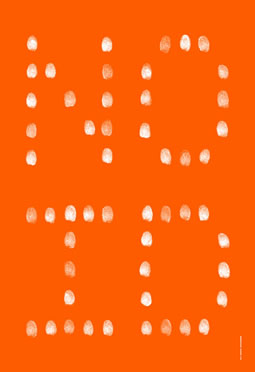
Martijn Sandberg’s contribution for this exhibition is a bright orange
poster with the fingerprinted text-‘NO ID’. Sandberg’s message
addresses the questions surrounding identification and identity in the
public as well as private spheres. Or, as he explains his ‘finger’
print: 'In this era we are not really asking ourselves, ‘to be or not
to be’, but rather ‘ID or no ID, that’s the question.’
The poster 'No ID' is on view in the backlit City Information
Panel (MUPI) at the Rokin in front of Arti et Amicitiae and inside the
exhibition space.
The Amsterdam-based artist Martijn Sandberg (1967) works on the tension
between text and image. He has designed his own typography that differs so
greatly from most fonts, most people do not recognize it as text. Sandberg
abstracts the appearance of the letters, reducing them to their essential structures and foregrounding
their strong ornamental quality. The 'image' hides the 'message'- one
that can only be decoded upon careful inspection.
Examples of this can be seen in his most recent works that engage with
architecture and public spaces. Two of them provoked a bit of
controversy- his covering the surface of a transformer station on the
Hoofddorpplein in Amsterdam with the repeated phrase 'Power To The
People' and the permanent installation 'We're Only In It For The Money'
at the SVB Bank, Zaandam NL.
Sandberg’s work is always on the edge between text and image. The image hides the
message-only by studying does one decipher the code.
Sharmila Samant
Sharmila Samant (IND)
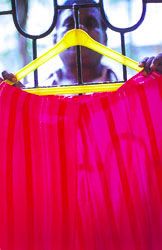
In her project ‘Hand Picked Rejects’ Sharmila Samant (re)presents clothing bought as rejects from ‘Fashion Street’ in Mumbai. Using her name and insignia she then signs them with thread, so as to give these lesser ‘seconds’ or ‘thirds’ the value of one-of-a-kind and exhibits/markets them in the wardrobe or storefronts of local well-known stores. (Laundry Industry)
http://www.opencirclearts.org/0sharmila.htmJan Rothuizen
Jan Rothuizen (NL)
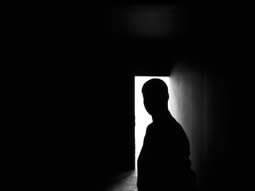
'In Between Space.'2004 Jan Rothuizen
Sound and light installation dimensions variable.
1 slide projector with 1 b/w slide.
1 CD player with 1 CD looped and 2 active speakers
"Nonetheless, the person who is fully human (l'homme totale) also
dwells in a 'lived space'('le vecu') of the imagination and
Moments which has been kept alive and accessible by the arts and
literature. This 'third'space not only transcends but has
the power to refigure the balance of popular 'perceived space'and the
'conceived space."
Henri Lefebvre, 'Production of Space'
Astrid Proll
Astrid Proll (DE)

Astrid Proll, a former member of the RAF in the early Seventies, has
carefully juxtapositioned media images with pictures from
her own archives. Although it is a subjective selection it is neither a
glorification of the RAF nor an angry accusation or denial. The author
has lived with the consequences of the RAF: escape, prison, career
restrictions. Having worked as a picture editor for many years she is
aware of the power of image-part of the function of her book is to
show how the media helped create the public image of RAF.
Astrid Proll was born in 1947 and became a member of RAF in the
late Sixties. She was imprisoned from 1971-1974. Her first trial in
1974 was suspended due to serious health problems. Astrid Proll escaped
to England where she was arrested in 1978 and extradited to Germany. In
1980 she had her second trial and was sentenced to five years on
probation but released from any charges of attempted murder. Since then
she has worked as a picture editor for magazines and newspapers
including Tempo and Wochenpost. This book is a narrative picture book
covering an important part of German post-war history. It deconstructs
the myth of the Red Army Fraction (RAF) and warns against creating more
heroes of armed struggles.
Federico d'Orazio
Federico d'Orazio
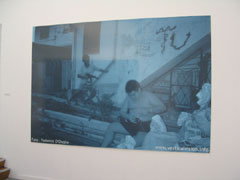
To Avoid the Void is an art project by Federico d'Orazio that begins with a work in public space.
This image To Avoid the Void was recently presented during the manifestation ARTWALK in the Staatsliedenbuurt in Amsterdam and installed near a children's playground. D'Orazio shows a minimal yet realistic image of children playing with guns. Is the image shocking because we know the chance is great that the children in this photograph might really come in contact with violence?
Arthur Neve
Arthur Neve (NL)
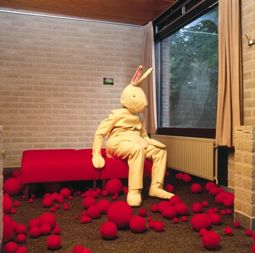
In the 'Het Beest'(The Beast) 2003, Arthur Neve offers his worldweary, beckett-ish alter-ego to the attention of the experts. Soul-bound to Dashiel Hammett's continental (h)op, a figure marooned in physicality and violence, this bunny shares in his deep and irreversable melancholia with the audience in an intimate video installation.
Renée Kool
Renée Kool (NL/F)
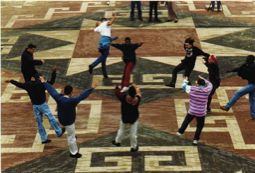
'Celebration' 1994
The youngest dansers rehearse for the video filming.
Festival a/d Werf 1994
Photo credit: Erik Weeda
'Celebration'
Work consisting of three parts: public staged event, video registration (BVUSP) docu-videoclip, television broadcasting
Duration videoclip: 8 minutes
Produced by the artist and Festival a/d Werf, Utrecht
Recording of the event: 25 May 1994
Broadcasted during the Festival: 25 May - 2 June 1994 (42 times)
'Celebration' is the result of a cooperative working process between the artist, disc-jockey
DNA and 15 male amateur hiphop dancers. The day of the shooting of 'Celebration' was
organised as a public event in which the inhabitants of the neighbourhood were invited to participate.
The 'circus' of activities that usually comes with tv-shooting in public had carefully been
prepared to serve as the opening event of the Utrecht Festival a/d Werf 1994.
The clip was recorded in the new square Amerhof designed by visual
artist Hans van Houwelingen. The intention was to make a mark in the
collective and individual memory
of the neighbourhood and its inhabitants.
'Celebration' was commissioned by Mark Kremer, curator of the section Visual Arts of the
Festival a/d Werf Utrecht.
Krishna Kaur
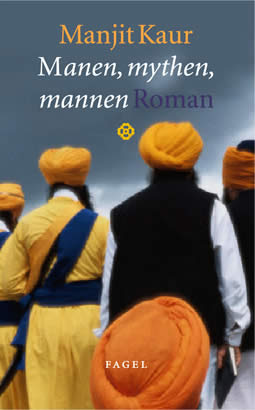
Krishna Manjit Kaur is a British/Asian Sikh. She is a writer, novelist as well as multimedia performance artist and film maker. Currently she in development with a film about Micro Credit systems based around the thesis "Does eradicating poverty mean eradicating culture". Her second novel "She's no woman, she's my daughter" is due out in April 2005.
Remy Jungerman
Remy Jungerman (SU/NL)
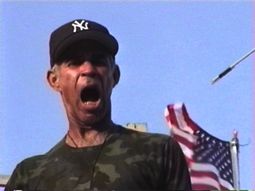
In the video ‘Territory’ Remy Jungerman presents an intimate portrayal of a freedom fighter, a no-man’s-land advocate and official founder of the ‘dead flattened toad territory’- a dynamic mix of post-colonial Surinamese culture, Winti (a local form of Voodoo) and nomadic mapping.
http://www.remyjungerman.comIratxe Jaio
Iratxe Jaio (ES/NL)
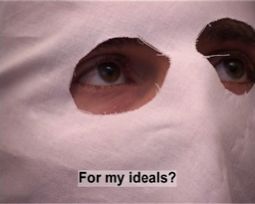
‘A 24 hours a day Revolution’ from Iratxe Jaio shows video interviews
of seeming Halloween ghostlike figures, masked participants of Basque
nationality, in an attempt to understand how far they would actually go
to defend their ideals and political viewpoints.

'Welcome to Belfast' 2004
New video installation
After the peace agreement in 1998, tourism became a developing industry in
Belfast. The city had to reconsider its public image. But how can a city
with such a history of conflict, that isn't completely over yet, make itself
attractive? And what role does the tourist have in the reorganization of
this society? "Welcome to Belfast" compiles images of a drummer practicing
for a parade, images of different loyalist flags and testimonies of three
outsiders explaining their experiences in the city"
More work: home.wanadoo.nl/klaasvangorkum/prestige
Ni Haifeng
Ni Haifeng (CN/NL)
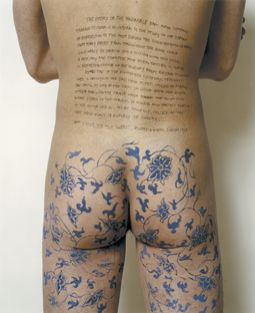
Ni Haifeng defines himself as a ‘Made in China’ export by painting texts and imagery on his body that relate to the Chinese/Dutch porcelain trade as well as contemporary marketing and third world production. Since the late nineties Ni Haifeng is preoccupied with photos related to representation(copy vs. original), cultural identity and the meaning of media in an image culture.
Rainer Ganahl
Rainer Ganahl (AT/US)
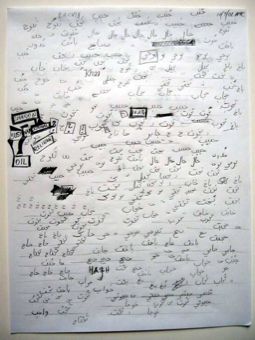
Basic Arabic (Study Sheet), 12/5/03 New York
(work on paper, 9 x 12 inches)
By assimilating different languages and linguistic phrases, Rainer Ganahl transmits different messaging systems through handwritten texts, video statements on media control tactics and performances and group readings of cultural theory. The video ‘Homeland Security’ might then be perceived as a subterfuge warning of the dangers involved.
Christina Erman Widerberg
Christina Erman Widerberg (S)

The Tattooer's Name
A film about a painter, a painting and a title...
Screening at the Palais de Festival, Shortfilm Corner, Festival de Cannes, May 21, 2004
Jn. Ulrick Désert
Jn. Ulrick Désert (HT/US/DE)
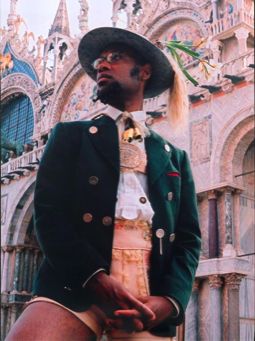
Jn.Ulrick Désert (HT/US/DE)
Jn.Ulrick Désert creates happenings such as ‘Negerhosen2000’ whereby he
portrays himself as a modern Western man, a man of leisure in modified
Caucasian skin colored “lederhosen". For this exhibition the artist has
created a travelogue series of Postcards utilizing documentary images during
the time of his Negerhosen2000 work in Europe. They are placed purposefully
juxtaposed against the backdrop of Rokin in Amsterdam Centrum.
Artist’s Statement
Negerhosen2000 is a multi-phased and form project and consists of
Performances, Documents, photography/video, installations, objects.
The artist wears caucasian flesh colored"Lederhosen" (Traditional folkwear
of Germanic territories) provoking discourse on cultural ownership,
identity, fantasy and race issues.
Negerhosen2000 was initiated as a performative response to having been
accosted in Berlin, Mitte.
Negerhosen2000 is an interrogation of the rhetoric of skin and identity. It
pits stereotypes against iconography.
Negerhosen2000 invites representational acts: tourists (as witness) provide
the evidentiary documentation for the initial manifestation. It is an
invitation of complicity in appropriation, power, fantasy and fetish in the
eye of the beholder.
Negerhosen2000 was deployed as a guerilla performance during DocumentaX and
Skulpturen Projekt in Kassel and Münster Germany respectively.
Negerhosen2000 is made of leather, hair, metal, wool, nakedness and history.
Its dimensions are variable and permutations ongoing.
Gary Carsley
Leigh Bowery †
Leigh Bowery † (AU/UK)

Leigh Bowery, periferal in the notion of art practice by combining
dandyism and body art, reconstructed his image while performing ‘Walk
this Way’- a rendition of Run DMC’s remake of Aerosmith’s
original that uses the expression of the ‘other’ to create a form of
cultural lip-syncing transvestism.
Copyright- Estate of Leigh Bowery, courtesy of Nicola Bowery and the archive of Dick Jewell.
With special thanks to Gary Carsley
Rob Birza
Rob Birza (NL)
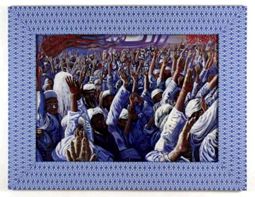
The gnawing question in the series ONE IS FREE circulates around the problematic relation between artist and reality. The machine-fabricated textile frames around the paintings accentuate an oriental atmosphere and emphasize a subtle play of colours between paint and textile. Rob Birza problemizes the painting as a window on reality - and while linked to almost psyhedelic-looking frames of textile, high art thus coincides with craft. Power, camouflage and the insertion of almost metaphysical looking colourfields work together demanding that the viwer take a stand, demanding that the viewer awake from his otheriwse accustomed and overly secure relationship with art.
The object, or the desire, the pleasure, frightens us greatly and we speak of threat, of allure, of repulsion, when we have to clarify it to ourselves later on.
(text borrowed from Paul Nouge, Luk Lambrecht)
Joseph Beuys †
Joseph Beuys † (DE)
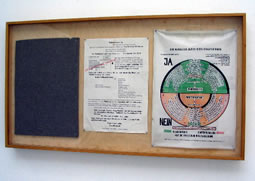
'How the dictatorship of the parties can be overcome'
thanks to Ritsaert ten Cate
June 1, 1971
Founding of the Organisation for Direct Democracy through Referendum
(a.k.a. Free People's Initiative, Inc.)
In the program of Direct Democracy through Referendum, Beuys places his
democratic system of intellectually legal and economic life in relation
to the three-structure idea of Rudolf Steiner and the ideals of the French
Revolution.
thanks to San Paolo Biennale 1979 catalogue
Goetz Adriani, Winfred Konnertz, Karin Thomas
Tiong Ang
Tiong Ang (IDR/NL)
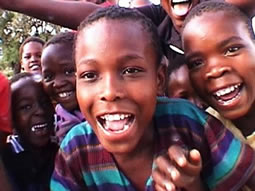
Tiong Ang, born in Indonsesia to Chinese immigrants and raised in the
Netherlands denies any connection to one ethnic group, rather
emphasizing his hybrid position. In his video 'Soweto', part of the M.I.T.R.
video program, he researches clichés and controversies pertaining to
diverse ethnic groups about perception and behavior and uses video
fragments to observe distance and participation, silence and mass
communication, watching and being watched.
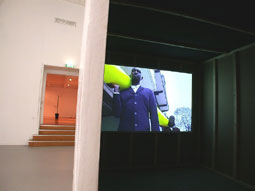
Tiong Ang - Parade, 2001-2004
single channel video installation,
loop dvd, 12' 30
featuring Atone Niane and Pape Dioum
The video shows two African men dressed in elegant suits walking
through Amsterdam, while carrying a bright yellow column on their
shoulders. Some shots shows the event in real time, the camera
following the men without interruption. Other shots show a more
cinematic orchestration of the parade, a montage of close-ups, long
shots, low angles, jump cuts, dissolves and slow motion that provides a
rhythmic counterpoint and accentuates a complex, multi-faceted view on
the men’s collaboration.
No explanation is given as to why these men are carrying this column,
where they are heading to or coming from. Carrying the column doesn’t
appear to be a necessary task or a delivery from one place to another.
The men seem to enjoy the seemingly goalless task of carrying a column
around on their shoulders for the fun of it. This joyous
purposelessness is an event in itself, a ritual or a parade.
originally produced for:
The Art of Waiting, a commission for Schiphol
International Airport, supported by Smart Project Space, Amsterdam, 2001
courtesy Lumen Travo Gallery, Amsterdam

